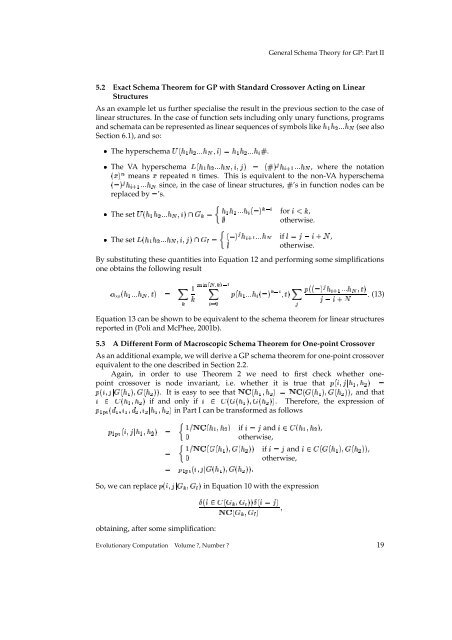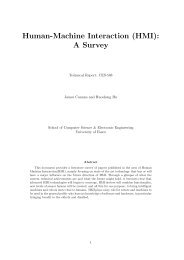General Schema Theory for Genetic Programming with Subtree ...
General Schema Theory for Genetic Programming with Subtree ...
General Schema Theory for Genetic Programming with Subtree ...
Create successful ePaper yourself
Turn your PDF publications into a flip-book with our unique Google optimized e-Paper software.
<strong>General</strong> <strong>Schema</strong> <strong>Theory</strong> <strong>for</strong> GP: Part II<br />
5.2 Exact <strong>Schema</strong> Theorem <strong>for</strong> GP <strong>with</strong> Standard Crossover Acting on Linear<br />
Structures<br />
As an example let us further specialise the result in the previous section to the case of<br />
linear structures. In the case of function sets including only unary functions, programs<br />
and schemata can be represented as linear sequences of symbols like ������� ����� ��� (see also<br />
Section 6.1), and so:<br />
�<br />
�<br />
�<br />
�<br />
The hyperschema ��¥�� � � � ����� � � §������ � � � � ����� � � � .<br />
The VA hyperschema ��¥�������� �<br />
§���§������ ¥ ��� �<br />
�<br />
� � ����� ��� , where the notation<br />
��� �����<br />
means ��� ¥�� � repeated times. This is equivalent to the non-VA hyperschema<br />
�<br />
�<br />
�<br />
�<br />
� � ����� � � since, in the case of linear structures, � ’s in function nodes can be<br />
¥ ���<br />
� replaced by ’s.<br />
The set ��¥�������� ����� ��� §������ �<br />
The set ��¥�������� ����� ��� §���§������ �<br />
�<br />
���<br />
�<br />
����� <strong>for</strong> ,<br />
otherwise.<br />
�<br />
���<br />
� ����� � � ¥ �<br />
��� � � �<br />
�<br />
�<br />
�<br />
� � ����� ��� if ������������� ,<br />
��� ¥<br />
�<br />
� otherwise.<br />
�<br />
By substituting these quantities into Equation 12 and per<strong>for</strong>ming some simplifications<br />
one obtains the following result<br />
� xo ¥���� ����� ��� §�©���� ���<br />
�<br />
�<br />
��� � � �<br />
�¡ £¢<br />
�<br />
� � � �<br />
� ���<br />
� � ¥ �<br />
��� §�©�� � � ����� ¥���� �<br />
�<br />
��� �<br />
�<br />
� � ����� ��� §�©�� ¥�¥ �<br />
���������<br />
� (13)<br />
Equation 13 can be shown to be equivalent to the schema theorem <strong>for</strong> linear structures<br />
reported in (Poli and McPhee, 2001b).<br />
5.3 A Different Form of Macroscopic <strong>Schema</strong> Theorem <strong>for</strong> One-point Crossover<br />
As an additional example, we will derive a GP schema theorem <strong>for</strong> one-point crossover<br />
equivalent to the one described in Section 2.2.<br />
Again, in order to use Theorem 2 we need to first check whether one-<br />
point crossover is node invariant, i.e. whether it � ¥ ��§���� ��� § ��� ���<br />
is true that<br />
��¥���� ��§ ��¥���� ��� . It is easy to see that � ¥ ��§���� ��� ���<br />
��� ¥���¥���� ��§ ��¥���� ��� , and that<br />
¥���� �<br />
�<br />
§ ���<br />
§ ��� � if and only if � � ¥���¥���� ��§ ��¥���� ��� . There<strong>for</strong>e, the expression of<br />
� � ¥����<br />
¥���� §�� � § ��� §�� � � ��� § ��� � in Part I can be trans<strong>for</strong>med as follows �<br />
� �¥¤ �<br />
� �¦¤ � ¥ ��§���� � � § � � ��� � �<br />
So, we can replace � ¥ ��§���� �<br />
��� § ��� � if ����� and � �<br />
§ ¥����<br />
� otherwise,<br />
§<br />
�<br />
��� ¥���¥�� � ��§ ��¥�� � ��� if ����� and � �<br />
� �<br />
otherwise,<br />
�<br />
� �¥¤ � ¥ ��§���� ��¥���� ��§ ��¥���� �����<br />
�<br />
�<br />
§ �<br />
�<br />
¥���� § ��� � ,<br />
� in Equation 10 <strong>with</strong> the expression<br />
� ¥ � �<br />
obtaining, after some simplification:<br />
�<br />
�<br />
§ �<br />
�<br />
��� � ¥ ������� ¥��<br />
¥��<br />
�<br />
§ �<br />
� §<br />
���<br />
�<br />
�<br />
¥���¥�� � ��§ ��¥�� � ��� ,<br />
Evolutionary Computation Volume ?, Number ? 19




